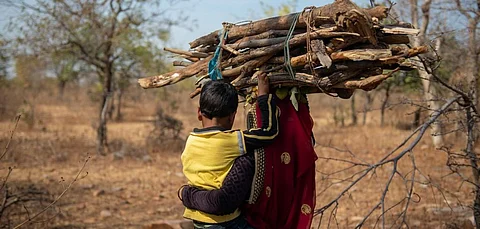Addressing indoor pollution and climate change with fuel-efficient cook stoves
This World Environment Day, as world leaders gather in China to deliberate on tackling air pollution, World Vision India (WVI), the organisation I work for, has tried a simple and tested tool to tackle indoor pollution in many poor Indian households, that often get caught between choices they make out of poverty and climate change-induced disasters.
Our field of operation was in 12 villages of Uttar Pradesh’s Lalitpur district, a region with a long history of droughts.
Rajkumari (36), a mother of two, spent four to five days a week collecting firewood from an ever-thinning forest close to her village. She only collected fallen branches, but this was a monotonous job that didn’t generate any income; it was just for survival. She often walked from the forest to her home, loaded with 20 kilograms (kgs) of wood on her head.
The average consumption of wood per family in her village is around 200 kgs per month. The locals believe this to be the major factor for deforestation. According to a survey done by WVI, 51.54 per cent of 1,200 households in the 12 villages walk more than 4 km to collect firewood.
During the survey, 70.50 per cent agreed that their surrounding areas had dense forest 30 years back. Some 89.69 per cent believe that deforestation has reduced agricultural productivity, whereas 65.64 per cent believe they now have to walk longer distance to fetch firewood. That deforestation has reduced water availability in the region is the opinion of 94.79 per cent of the people.
Deforestation, indoor pollution and climate change are all linked through a complex system. The use of the Chulha, the traditional Indian cooking stove, raises major health and environmental concerns. The Chulha is a major contributor of air pollution in rural India.
About one-third of the world’s households and up to 95 per cent of people in poor countries burn wood, dung, peat and other biomass fuels, as well as coal, for energy. As women are primarily responsible for cooking, and children often spend time with their mothers — women and young children are disproportionately affected by the indoor air pollution caused by the use of solid fuels and traditional stoves.
The World Health Organization (WHO) estimates that indoor air pollution contributes to nearly 3.8 million deaths because of household exposure to smoke from dirty cook stoves and fuels. Pollution contributed to over 1.2 million deaths in India in 2017 according to the State of Global Air 2019, published by the Health Effects Institute in Boston, United States.
The Chulha produces carbon dioxide, methane and particulate matter that contributes to global warming. The traditional Chulha consumes tonnes of wood, which is an unsustainable way of life, in a region already ravaged by drought.
Rajkumari’s daughter Roshni, 15, and son, Rishab, 5, too have felt the impact of indoor pollution one way or the other. The family of four cook, dine and sleep in a shared one room space. Smoke from cooking makes it hazardous, especially for children.
According to WHO, around 93 per cent of the world’s children under the age of 15 years (1.8 billion children) breathe polluted air every day, that puts their health and development at risk.
WHO estimated 600,000 child deaths in 2016 from acute lower respiratory infections caused by polluted air, making air pollution one of the biggest killers of children under the age of five years.
In 2018, WVI provided tried and tested, fuel-efficient cook stoves to the 1,200 families as part of an initiative to address indoor pollution in the 12 villages of Lalitpur.
To measure the intangible impact of fuel-efficient cook stoves, we carried out indoor air quality testing through High Volume Air Sampler. Twenty households were chosen randomly in 10 villages and each test was run continuously for 24 hours. Indoor air quality sampling was done before and after the introduction of fuel-efficient cook stoves and the result is quite encouraging.
Findings of World Vision India's tests in Lalitpur. Credit: World Vision India Survey
Ninety-five per cent of the beneficiaries felt that the cook stoves had helped their children in their education by allowing parents to spend more time with their kids in studies. Ninety-eight per cent mothers were positive of reduced smoke emission in their homes, and reported 50 per cent reduction in firewood fuel consumption.
“It burns like a gas, cooks faster and doesn’t collect soot. Earlier, I had to go 4-5 days a week to collect firewood, now I go twice a month only. I can now spend more time with my children, even while cooking,” said Rajkumari.
Cutting forests for firewood and farming had ruptured the ecosystem and set off a chain reaction. Fuel-efficient and smokeless cook stoves have shown themselves to be capable of solving many of these problems in rural Lalitpur, where the balance between the land and the people is a delicate one.
These initiatives will not only lead to healthy living, but will also help in improving social, financial and environmental conditions of rural India.
Often, providing a context-friendly and simple solution, which is easily accessible to vulnerable and poor communities, can prove to be more effective in addressing environmental issues.
Jim Kasom is Communication associate in World Vision India, global grassroots humanitarian organisation


